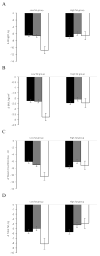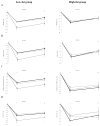A circadian rhythm-related MTNR1B genetic variant modulates the effect of weight-loss diets on changes in adiposity and body composition: the POUNDS Lost trial
- PMID: 29516223
- PMCID: PMC6128782
- DOI: 10.1007/s00394-018-1660-y
A circadian rhythm-related MTNR1B genetic variant modulates the effect of weight-loss diets on changes in adiposity and body composition: the POUNDS Lost trial
Abstract
Purpose: A common variant of the melatonin receptor 1B (MTNR1B) gene has been related to increased signaling of melatonin, a hormone previously associated with body fatness mainly through effects on energy metabolism. We examined whether the MTNR1B variant affects changes of body fatness and composition in response to a dietary weight loss intervention.
Methods: The MTNR1B rs10830963 variant was genotyped for 722 overweight and obese individuals, who were randomly assigned to one of four diets varying in macronutrient composition. Anthropometric and body composition measurements (DXA scan) were collected at baseline and at 6 and 24 months of follow-up.
Results: Statistically significant interactions were observed between the MTNR1B genotype and low-/high-fat diet on changes in weight, body mass index (BMI), waist circumference (WC) and total body fat (p interaction = 0.01, 0.02, 0.002 and 0.04, respectively), at 6 months of dietary intervention. In the low-fat diet group, increasing number of the sleep disruption-related G allele was significantly associated with a decrease in weight (p = 0.004), BMI (p = 0.005) and WC (p = 0.001). In the high-fat diet group, carrying the G allele was positively associated with changes in body fat (p = 0.03). At 2 years, the associations remained statistically significant for changes in body weight (p = 0.02), BMI (p = 0.02) and WC (p = 0.048) in the low-fat diet group, although the gene-diet interaction became less significant.
Conclusions: The results suggest that carriers of the G allele of the MTNR1B rs10830963 may have a greater improvement in body adiposity and fat distribution when eating a low-fat diet.
Keywords: Adiposity; Gene–diet interaction; High-fat diet; Melatonin receptor 1B; Weight-loss intervention.
Conflict of interest statement
The authors declare that they have no conflict of interest.
Figures


Similar articles
-
Macronutrient Intake-Associated FGF21 Genotype Modifies Effects of Weight-Loss Diets on 2-Year Changes of Central Adiposity and Body Composition: The POUNDS Lost Trial.Diabetes Care. 2016 Nov;39(11):1909-1914. doi: 10.2337/dc16-1111. Epub 2016 Aug 31. Diabetes Care. 2016. PMID: 27581055 Free PMC article.
-
A circadian rhythm-related MTNR1B genetic variant (rs10830963) modulate body weight change and insulin resistance after 9 months of a high protein/low carbohydrate vs a standard hypocaloric diet.J Diabetes Complications. 2020 Apr;34(4):107534. doi: 10.1016/j.jdiacomp.2020.107534. Epub 2020 Jan 13. J Diabetes Complications. 2020. PMID: 32057567 Clinical Trial.
-
Macronutrient-specific effect of the MTNR1B genotype on lipid levels in response to 2 year weight-loss diets.J Lipid Res. 2018 Jan;59(1):155-161. doi: 10.1194/jlr.P078634. Epub 2017 Oct 31. J Lipid Res. 2018. PMID: 29089366 Free PMC article. Clinical Trial.
-
The melatonin receptor 1B gene links circadian rhythms and type 2 diabetes mellitus: an evolutionary story.Ann Med. 2023 Dec;55(1):1262-1286. doi: 10.1080/07853890.2023.2191218. Ann Med. 2023. PMID: 36974476 Free PMC article. Review.
-
Effects of total fat intake on body fatness in adults.Cochrane Database Syst Rev. 2020 Jun 1;6(6):CD013636. doi: 10.1002/14651858.CD013636. Cochrane Database Syst Rev. 2020. PMID: 32476140 Free PMC article.
Cited by
-
Gene-Environment Interactions on Body Fat Distribution.Int J Mol Sci. 2019 Jul 27;20(15):3690. doi: 10.3390/ijms20153690. Int J Mol Sci. 2019. PMID: 31357654 Free PMC article. Review.
-
Maternal MTNR1B genotype, maternal gestational weight gain, and childhood obesity.Am J Clin Nutr. 2020 Feb 1;111(2):360-368. doi: 10.1093/ajcn/nqz296. Am J Clin Nutr. 2020. PMID: 31826236 Free PMC article.
-
CETP and APOA2 polymorphisms are associated with weight loss and healthy eating behavior changes in response to digital lifestyle modifications.Sci Rep. 2023 Dec 7;13(1):21615. doi: 10.1038/s41598-023-48823-w. Sci Rep. 2023. PMID: 38062157 Free PMC article.
-
Lessons Learned from the POUNDS Lost Study: Genetic, Metabolic, and Behavioral Factors Affecting Changes in Body Weight, Body Composition, and Cardiometabolic Risk.Curr Obes Rep. 2019 Sep;8(3):262-283. doi: 10.1007/s13679-019-00353-1. Curr Obes Rep. 2019. PMID: 31214942 Review.
-
Combined effects of genetic background and diet on mouse metabolism and gene expression.iScience. 2024 Nov 4;27(12):111323. doi: 10.1016/j.isci.2024.111323. eCollection 2024 Dec 20. iScience. 2024. PMID: 39640571 Free PMC article.
References
MeSH terms
Substances
Grants and funding
- R01 DK078616/DK/NIDDK NIH HHS/United States
- HL-126024/HL/NHLBI NIH HHS/United States
- R01 DK115679/DK/NIDDK NIH HHS/United States
- DK-100383/DK/NIDDK NIH HHS/United States
- HL-071981/HL/NHLBI NIH HHS/United States
- P30 DK046200/DK/NIDDK NIH HHS/United States
- R21 HL126024/HL/NHLBI NIH HHS/United States
- DK-091718/DK/NIDDK NIH HHS/United States
- R01 HL034594/HL/NHLBI NIH HHS/United States
- R01 HL071981/HL/NHLBI NIH HHS/United States
- UM1 DK078616/DK/NIDDK NIH HHS/United States
- DK-46200/Boston Obesity Nutrition Research Center
- HL-034594/HL/NHLBI NIH HHS/United States
- R01 DK091718/DK/NIDDK NIH HHS/United States
- U01 DK078616/DK/NIDDK NIH HHS/United States
- R01 DK100383/DK/NIDDK NIH HHS/United States
- DK-078616/DK/NIDDK NIH HHS/United States
- 2011036/United States-Israel Binational Science Foundation
LinkOut - more resources
Full Text Sources
Other Literature Sources
Medical

